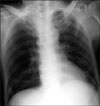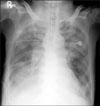Abstract
Torsades de pointes associated with a prolonged QT interval is a life-threatening arrhythmia, which may be induced by any of the following: drugs, electrolyte imbalances, severe bradycardia and intracranial hemorrhage. Torsades de pointes is characterized by beat-to-beat variations in the QRS complexes in any ECG leads with rates of 200~250 per minute. Fluoroquinolones are widely used and well tolerated antibacterial agents. However, prolongation of the QT interval leads rarely to Torsades de pointes as a significant adverse effect. So, it should be used with caution in high-risk patients for developing Torsades de pointes. We report one case of 67-year old man with contact burns who experienced Torsades de pointes, which probably resulted from the use of levofloxacin, and no further episode occurred after its withdrawal.
Figures and Tables
 | Figure 4Electrocardiogram during the use of levofloxacin. QT prolongation, T wave inversion and polymorphic ventricular tachycardia are noted. |
 | Figure 6Chest X-ray showed marked improved pulmonary edema and pleural effusion at the 21st hospital day. |
References
1. Owens RC Jr, Ambrose PG. Antimicrobial safety: focus on fluoroquinolones. Clin Infect Dis. 2005. 41:Suppl 2. S144–S157.
2. Dessertenne F. La tachycardie ventriculaire à deux foyers opposés variables [Ventricular tachycardia with 2 variable opposing foci]. Arch Mal Coeur Vaiss. 1966. 59:263–272.
3. Roden DM. Drug-induced prolongation of the QT interval. N Engl J Med. 2004. 350:1013–1022.
4. Viskin S, Justo D, Halkin A, Zeltser D. Long QT syndrome caused by noncardiac drugs. Prog Cardiovasc Dis. 2003. 45:415–427.
5. Kay GN, Plumb VJ, Arciniegas JG, Henthorn RW, Waldo AL. Torsade de pointes: the long-short initiating sequence and other clinical features: observations in 32 patients. J Am Coll Cardiol. 1983. 2:806–817.
6. Kim JH, Nam GB, Lim JM, Huh JW, Kim SY, Rhee KS, et al. A case of ofloxacin-induced torsades de pointes and abnormal ECG change mimicking acute myocardial infarction. Korean Circ J. 2002. 32:815–819.
7. Kwon JW, Kang WC, Lee MH, Ahn SK, Kim SS. A case of hydroxyzine induced torsades de pointes. Korean Circ J. 1998. 28:1011–1016.
8. Park SJ, Kim KH, Kim JS, Ryu JC, Joo SB, Gwon HC, et al. Torsades de Pointes after combined treatment of terfenadine and ketoconazole. Korean J Med. 1998. 54:124–130.
9. Letsas KP, Alexanian IP, Pappas LK, Kounas SP, Efremidis M, Sideris A, et al. QT interval prolongation and torsade de pointes associated with indapamide. Int J Cardiol. 2006. 112:373–374.
10. Patel PD, Afshar H, Birnbaum Y. Levofloxacin-induced torsades de pointes. Tex Heart Inst J. 2010. 37:216–217.
11. Frothingham R. Rates of torsades de pointes associated with ciprofloxacin, ofloxacin, levofloxacin, gatifloxacin, and moxifloxacin. Pharmacotherapy. 2001. 21:1468–1472.
12. Noel GJ, Natarajan J, Chien S, Hunt TL, Goodman DB, Abels R. Effects of three fluoroquinolones on QT interval in healthy adults after single doses. Clin Pharmacol Ther. 2003. 73:292–303.
13. Tsikouris JP, Peeters MJ, Cox CD, Meyerrose GE, Seifert CF. Effects of three fluoroquinolones on QT analysis after standard treatment courses. Ann Noninvasive Electrocardiol. 2006. 11:52–56.
14. Kang J, Wang L, Chen XL, Triggle DJ, Rampe D. Interactions of a series of fluoroquinolone antibacterial drugs with the human cardiac K+ channel HERG. Mol Pharmacol. 2001. 59:122–126.
15. Bazett HC. An analysis of the time-relations of electrocardiograms. Heart. 1920. 7:353–370.




 PDF
PDF ePub
ePub Citation
Citation Print
Print








 XML Download
XML Download